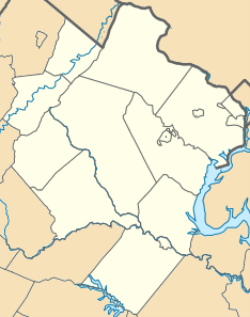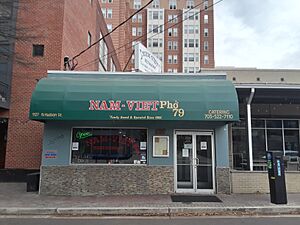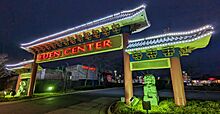Little Saigon, Arlington, Virginia facts for kids
Quick facts for kids
Little Saigon, Arlington, Virginia
|
|
|---|---|
| Clarendon, Arlington, Virginia | |
| Country | |
| State | |
| County | |
| Time zone | UTC-5 (EST) |
| • Summer (DST) | UTC-4 (EDT) |
| ZIP codes |
22201
|
| Area codes | 703 and 571 |
Little Saigon was a special neighborhood in Clarendon, Virginia. It was a place where many Vietnamese people lived and ran businesses. This community grew after the Fall of Saigon in 1975, when many refugees came to the United States.
Little Saigon became a busy center for Vietnamese shops and social life. It was most active from the late 1970s to the early 1980s. However, new building projects and higher rents caused many businesses to close or move. A new shopping area called Eden Center became a popular spot for Vietnamese businesses instead.
Contents
Why Vietnamese People Came to the U.S.
Toward the end of the Vietnam War in the 1970s, many people left Vietnam. Before 1975, only about 15,000 Vietnamese immigrants lived in the United States. By 1980, this number grew to about 245,000. Most of them had arrived in the five years before 1980.
Two Waves of Immigration
Vietnamese immigrants came to the U.S. in two main groups. The first large group arrived in 1975. These were often educated people or those who had worked for the former South Vietnamese government. They left because they feared for their lives or worried about being imprisoned.
Later, from the mid-1970s to the early 1990s, many refugees left Vietnam by boat. These people are often called "boat people." They were generally less educated than the first group. Hundreds of thousands of people fled Vietnam by boat during this time.
Choosing Northern Virginia
The Washington metropolitan area was a good place for Vietnamese immigrants to settle. Many first-wave immigrants had connections to the U.S. government or the embassy in Vietnam. Northern Virginia was a good spot because embassy officials suggested it. Also, groups like the Catholic Church helped new arrivals find sponsors.
Once some immigrants settled in Arlington, their families and friends joined them. By the end of the Vietnam War, about 3,000 Vietnamese people lived in the Washington, D.C. area. Many more came later. The busiest Vietnamese areas in Northern Virginia were along Wilson Boulevard and Columbia Pike.
Clarendon's Transformation
In the mid-1900s, Clarendon was a busy shopping area in Arlington. But in the 1960s and 70s, new shopping malls caused Clarendon to decline. Many stores moved away, leaving empty buildings. Also, construction for the Washington Metro's Clarendon station began in the mid-1970s.
These changes made rents very cheap, sometimes as low as $1.50 to $5 per square foot. This was a great chance for Vietnamese refugees to open businesses. They could support their families and rebuild their lives.
New Businesses and Community Life
The first Vietnamese business, the Saigon Market grocery store, opened in 1972. Soon, more Vietnamese people opened shops and restaurants. Clarendon quickly became a lively center for the Vietnamese community on the East Coast. Groups helping refugees even organized trips to bring people from other areas to shop in Clarendon.
Little Saigon had many different kinds of businesses. Grocery stores were very popular because they sold special ingredients not found in American markets. Some places felt like a flea market, with several small businesses inside one building. For example, My An Fabric store also had a billiards room and a small cafe.
The community celebrated holidays like the annual Moon Festival. A restaurant owner named Nguyen Van Thoi even hosted a special Tet dinner for American prisoners of war for 19 years.
Challenges for Business Owners
Vietnamese business owners faced many challenges. Banks often wouldn't lend them money. So, they had to borrow from friends and family, sometimes at higher interest rates. Some owners also had trouble understanding business rules and licenses, which led to fines. To get money, some immigrants even sold their family's gold and jewelry.
Over time, the Vietnamese-American business community grew stronger. Toa Do, who started as a messenger, became the first Vietnamese person on the Arlington Chamber of Commerce. A group called the Clarendon Vietnamese Retail Business Association was also formed. It aimed to help Vietnamese businesses and speak up for their interests.
The Decline of Little Saigon
Little Saigon began to change for several reasons. Many building owners didn't fix up their properties. They were waiting for the Metro station to open and for new development plans. Even after the Metro opened in 1979, big new projects didn't happen right away. It was hard for developers to buy enough land because many small plots were owned by different people.
In 1989, Arlington County approved a new plan for Clarendon. This plan included tall commercial buildings, mid-rise homes, parks, and walking paths. It also offered ways to encourage smaller businesses.
Rising Rents and Relocation
Eventually, rents in Clarendon started to go up, sometimes to $25–30 per square foot. This made it too expensive for many Vietnamese businesses and families. They began to move westward, especially to areas around Seven Corners and Falls Church. By 1984, 60% of Vietnamese-Americans in the area lived within three miles of Seven Corners.
The number of Vietnamese businesses in Little Saigon slowly decreased. In 1989, a business group noted that out of 76 businesses in Clarendon, about 30 to 35 were Asian-owned, mostly Vietnamese. These included grocery stores, real estate offices, law firms, and restaurants. That same year, several businesses, like Mekong Center grocery store, moved out of the Hartford Building before it was torn down.
Even though the crowds of Vietnamese customers got smaller, the remaining businesses still did well. However, Little Saigon was no longer the main community meeting place it once was. Some business owners felt upset about being pushed out. Others were able to move to new shopping centers that offered better parking and maintained properties.
Later, Arlington County tried to help small ethnic businesses. In 1993, they published a guide in both English and Vietnamese on how to start a business. The county also started offering ongoing help to small businesses.
By 2014, Clarendon had mostly changed into a mix of retail stores, bars, restaurants, and offices. The new buildings were much larger, often too big for small, independent businesses. As of 2014, the Nam Viet restaurant was the only original Vietnamese business left from Little Saigon.
The Rise of Eden Center
In 1984, the Eden Center shopping mall opened in the Seven Corners area of Falls Church. It offered 20,000 square feet of affordable space for stores.
In 1997, Eden Center added more space and a famous clock tower. At that time, it was the largest Vietnamese shopping area in the U.S. Eden Center quickly became the new main hub for Vietnamese businesses and activities. In 2007, a special exhibit about Vietnamese American immigration was even shown there.
Today, Eden Center is seen as the central place for Vietnamese services and goods in Northern Virginia and the entire East Coast. In 2014, it had 120 stores and restaurants, almost all of them Vietnamese.
Remembering Little Saigon
In 2014, a special project began to collect the stories of the Vietnamese community from Little Saigon. The Arlington County Public Library, local historians, and students worked together. They interviewed people who lived, shopped, or owned businesses in Little Saigon.
People shared their memories, photos, and videos. These items are now kept at the Arlington County Library. Many Vietnamese-Americans took part in this project to share their experiences. The students suggested creating a historical marker or monument. This would help remember Little Saigon and honor the contributions of Vietnamese refugees to Arlington's history.






